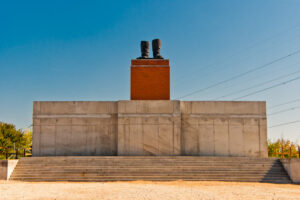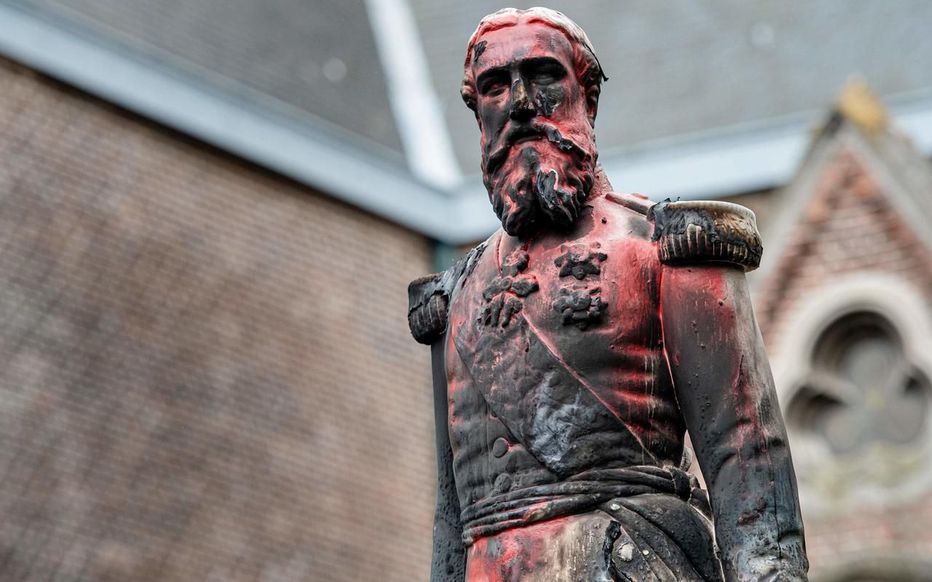A statue of King Leopold II of Belgium was set alight and covered in red paint. Antwerp, 4 June 2020.
Whether in the context of the West reckoning with its colonial past or former Soviet states reconciling antagonistic historical narratives to recover or reaffirm their own distinct identities, over the past three decades, contested histories have increasingly served as a flashpoint for conflict.
Last Friday, the OSCE High Commissioner on National Minorities issued a letter on symbols in public spaces to Ambassadors of 57 OSCE Participating States that underscores the importance of respecting the ways individuals relate themselves to history when attempting to resolve contestations around historical legacies. The institution of the OSCE High Commissioner on National Minorities is an instrument of conflict prevention at the earliest possible stage. Its mandate involves containing and de-escalating tensions involving national minorities by providing early warning and early action where a situation has the potential to turn into a conflict.

In this letter, the High Commissioner highlighted his own experience engaging with groups throughout the OSCE region where opposing perceptions of history and their tangible, public representations have led to instability. It is understood that differing interpretations of historical legacies can exacerbate internal tensions and that the exploitation of memory can have geopolitical implications, spurring the involvement of kin-states in domestic issues of sovereign states. To contribute to greater societal cohesiveness and transnational security, the HCNM supports the establishment of consultative processes with clear mandates that include representatives from aggrieved groups.
The Institute for Historical Justice and Reconciliation’s Contested Histories project understands that, in almost all cases, calls for the removal of statues, renaming of streets, and reframing of school or university curricula, are symptomatic of deeper divisions within societies. Confronted with public protests and social media campaigns, decision-makers often respond in haste, out of panic, and without the benefit of established principles, processes, or best practices. This results in inadequate, ineffective, or arbitrary remedies with unintended long-term consequences, including but not limited to ‘whitewashing’, i.e., purposeful public forgetting of traumatic events and contentious figures, through erasure (destruction or removal). This failure to engage society in critical discourse about historical traumas can fuel further conflict.
In recent articles published by EuroClio, Le Monde, and Novoye Vremya, the Contested Histories team presented possible solutions for such contestations over monuments, among them remedies that facilitate important educational discussions and contribute to raising awareness of historical wrongdoings. Placarding, additive elements, and counter monuments are just a few examples of remedies that can serve to contextualize historical legacies and foster debate and discussion. Removal and destruction are underscored as tools of last resort reserved for extreme cases. The CH team stands firmly behind the idea that erasure of scars on a community’s landscape alone cannot conceal or heal the influence of ones on the public’s psyche.
Read the full text of the High Commissioner’s Open letter on symbols in public spaces here.
About the Contested Histories project
The Institute for Historical Justice and Reconciliation is a research center at EuroClio that works in cooperation with a range of public, private, and independent institutions.
The Contested Histories project seeks to identify, document, and examine cases of contestation around the world with the goal of identifying a set of principles, processes, and best practices that inform decision making. To this end, the IHJR has identified and conducted research on more than a hundred cases in Africa, Asia, Australia, Europe, and the Americas. At present, an interactive web platform that will host a digital map and related database is under construction and will soon be accessible to a wide range of stakeholders. Although each case is unique and underlying causes are context-specific, the CH team is confident that the aggregated materials will (a) provide insights that facilitate better-informed decision making in response to future contestations and (b) serve as a resource for educators interested in examining multi-perspective approaches to history education.
Follow the work of the Contested Histories project here.













